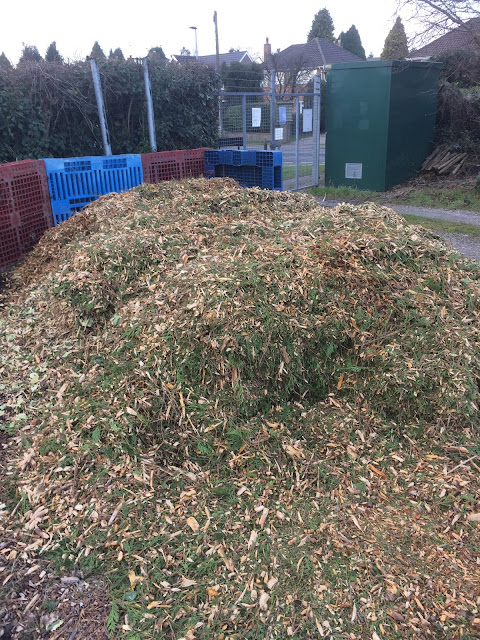I dug down one spit today and left the soil on the side of the trench.
I always use garden lines because I can't keep a straight line without them. There are lots of reasons for not digging but there is no other way of introducing large quantities of organic matter and deepening the top soil. I will take another spit out of the bottom of the trench and then fork over the bottom which will give me three spits of turned over soil. Loads of waste material from around the allotment will be used to put into the trench.
The old vegetables from last season. A few celery and celeriac together with carrots and beetroot.
Old bits of wood that I have collected from under the hedge and in the woody chippings piles. I will probably get some more before I fill in the trench. I will certainly clean the bottom of the hedge a little more.
The logs off the lorry. These will go at the bottom of the trench. I think they are mostly cherry laurel.
I will move the frames off the hot bed, which has not been that hot during the winter. The woody chippings have rotted down now and will go at the bottom of the trench. I will put the frames on top soil now and just rely on the glass to heat the soil.
If that is not enough shreddings, I will resort to the woody chippings pile to add more woody material.
Mostly X Cupressocyparis laylandii and holly but it is all grist to the mill. I will also be putting the cuttings from my daughter's garden in the trench too. It will all be two spits down and can moulder there for a year under the potatoes and whichever green manure I plant after them.
The top soil is deepening and now is more than a spit deep. The subsoil is darkening with organic matter too. Deeper topsoil means more organic matter, more nutrients, more microbes, more water and more air for vegetable roots to delve into.
Now I am going to try and explain why I think that it is a good idea to introduce organic matter into the subsoil as deep as I can. In normal conditions plants can get water and dissolved nutrients easily from the top soil. There is usually decomposition going on and nutrients being released. As drought conditions start to appear the roots start to forage for water lower and lower in the soil profile. The dry top soil means that they cannot obtain nutrients from here because there is no water to dissolve them in. Nutrients can only enter the root as dissolved ions. As the roots pass out of the dry topsoil they pass into the moist but infertile subsoil where nutrients are much more scarce. Little is dissolved in this water and although the plants have adequate water they begin to get nutrient shortages. Bottom old leaves start to yellow as nitrogen is transported away to the growing tips, although the plant is not wilting. If we can deepen the soil, adding lots of organic matter, it will make plants more able to withstand drought conditions and the shortage of nutrients that it might bring.
So that's what I have been doing today - that and turning one of the compost bins. I will use the compost to mix in with the top soil as I rake it back into the trench.













